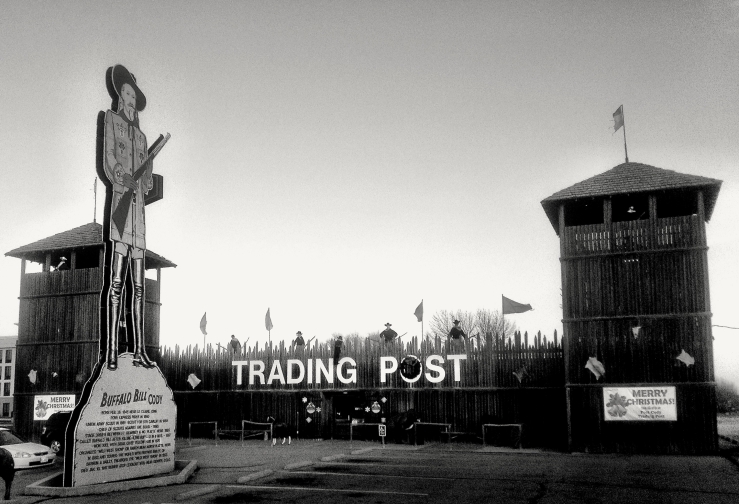I should note that being my first post for this blog that I was born and raised (for the most part) in Chamberlain, SD, which fits the commonly understood notion of being a border town. Chamberlain is geographically located near two reservations–the Crow Creek Sioux Tribe and my tribe the Lower Brule Sioux Tribe.

On my way back home from school in Albuquerque, NM, I drove through North Platte, NE. North Platte is an historic site that is positioned on the most southern border of treaty land designated as “Sioux Territory” by the 1868 Fort Laramie Treaty. As I turned North onto Highway 83 from I-76, this is the site that welcomed by return to the treaty lands of my people, the Oceti Sakowin Oyate (Nation of the Seven Council Fires).
The image of an American military outpost with highwalls and armaments is metaphorical of the historic political and economic currency of border towns–Indians. As much as border towns have historically attempted to keep Natives out (like the high walls of the fort suggest), their political and economic livelihood is intrinsically dependent on Native people and land.
This prompted me to think about the concept of border towns. Native and non-Native people constantly refer to border towns, as if it is commonly understood term. But what exactly is a border town? How does it function?
Here are some broader definitions I came up with listed in no particular order:
- Geographic location near an Indian reservation and/or community;
- Dependent upon Native resources such as: land, cheap labor, water, mineral resources, and economies;
- In some cases Native people are dependent upon border towns for basic needs such as: employment, food, education, access to health services, access to social services, and conducting business in general;
- Disproportionate wealth and living conditions between non-Native and Native people living in or dependent on border towns;
- Disproportionate criminal conviction rate of Native people when compared to non-Native people;
- and, Disproportionate violence against Native women.
I researched scholarly definitions of border towns and Native people, but only found legal and civil/human rights commissions reports that deal with border town issues. So these definitions are solely mine as defined by my personal experience and research. Yet, given these broad definitions of border towns, border towns are not wholly unique to the Great Plains or the United States. These definitions parallel the relationship between First World and Third World nations.
Take for example, border towns on the border between Mexico and the United States. Why is there such a distinct, disproportionate level of violence and poverty on one side and not the other? Most people blame drugs as the sole motivating factor for the escalation of violence on the border. But, it begs the questions: who and what is fueling this demand for drugs? Why have we forgotten about NAFTA? Considering how critics of NAFTA determined the negative effects it would have on Mexico, criticism of NAFTA has been all but forgotten. Because sustained criticism of NAFTA has been abandoned does not mean U.S.’s continued exploitation and economic dependence on unfair market conditions is not a contributing factor to ongoing violence along the border. This relationship the First World has with Third World countries is a global phenomenon of capitalism. The same goes for border town communities in the U.S., except the exchange is different. The violence, however, is similar.
It seems, however, just like in the case of forgetting the devastating effects NAFTA would have on Mexico, the violence that accompanied the invasion of America by European colonizers is rendered as an historic occurance that has no bearing in the present. America sees itself as abandoning these past violences–morally moving beyond them. Using the distance of time to abandon and forget the violent past is a trick that does not interrogate the present disparities that exist in border towns, nor the violences they perpetuate.
The idea of borders are meant to create boundaries between people–physical spaces that are meant to keep out and keep in. They define who is deemed worthy and therefore included. Conversely, they define who is deemed unworthy and excluded. Internally, within the settlements around which borders are constructed, the morals and values constructed by those who are worthy are thus used to define those who belong. Those who are meant to be excluded and deemed unworthy decidedly do not constitute a valid existence when they transgress borders into communities that do not want them there.
Likewise, if we take into consideration the United States in the broader context of the history of colonialism, every settlement in America benefits from Native land dispossession. This dispossession was by no means peaceful. It was and is the primary motivating factor for the continuation of colonial violence in the present. Further study needs to take place that examines the logics behind border towns as an historic and contemporary phenomenon.
To be continued.
[…] I have thought over the definitions of a border town, I have come to the conclusion that border towns like Rapid City do not easily fit the common […]
[…] on the research and theoretical work I’ve been doing on border towns since 2012, see: Border Towns: Colonial Logics of Violence, Indian Casino Cartels or Alcohol Cartels? Farmington, NM, First Nations Sculpture Garden: Rapid […]
[…] song. And Chamberlain, despite its best attempts, will never live this down. It will haunt this border town in the annals of history. It will, as they say, go down in […]
[…] song. And Chamberlain, despite its best attempts, will never live this down. It will haunt this border town in the annals of history. It will, as they say, go down in […]